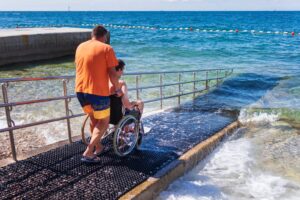Accessible Tourism – Truths, Tips & Trends
Who benefits from accessible tourism? Everyone does.
More people get the opportunity to enjoy travel destinations they may not have been able to visit with ease (or at all) before. The tourism industry welcomes more visitors. New jobs become available in the travel sector. In fact, it’s quite likely that you or someone you know can benefit from more inclusive travel now or will in the foreseeable future.
There’s a big world out there, and accessible tourism wants everyone to be able to explore it.

At its core, accessible tourism is the ongoing endeavor to create leisure locations that are accessible to all people, regardless of physical limitations, disabilities or age. This group includes physical, sensory and mental disabilities, elderly people, parents pushing children in strollers and those with temporary disabilities, e.g., a broken leg.
The World Health Organization estimates that 15% of the global population has some form of disability. This percentage translates into an estimated 1 billion people living in the world today. So, it goes without saying that travel that is designed to be easier, smoother, more inclusive and ultimately more enjoyable should be a common goal shared by all.
The Americans with Disabilities Act (ADA) of 1990 strengthened the rights of people with disabilities to access goods and services on an equal basis with individuals without disabilities.
You may notice ADA-compliant ramps and beach mats springing up along shorelines throughout the U.S., sensory-friendly live performances, barrier-free arts & culture destinations and boundless playgrounds, as well as accessible recreational trails and parks. While much work still needs to be done, there are many positive changes happening in the worldwide travel sector.

Fully accessible multi-day group tours with inclusive accommodations and specially trained guides are becoming more frequent. Many cruise lines now offer autism-friendly, interactive initiatives for families, including sensory-friendly films, toys, dietary menu options, special training for staff and more.
These changes can be seen globally as well. Travel + Leisure recently reported locations such as Jerusalem are striving to become more accessible to visitors of all abilities. The city has installed ramps to make its stone streets wheelchair accessible and has made improvements to nearly four miles of alleyways.
A leader in travel and tourism marketing, Dana Communications recognizes the importance of inclusive travel and keeps a keen eye on changes taking place in the travel industry today. We spotlight accessibility for a variety of clients, including the New Jersey Division of Travel and Tourism and work to bring awareness to ADA-compliant beaches, arts and culture destinations, nature areas, children’s playgrounds and more.
Wherever your journey takes you, stay in tune with the latest travel trends and top-rated locales and attractions that cater to both your interests and your needs. For more ways to map out the adventure of your dreams, turn to the marketing expertise of Dana Communications. Contact Lynn Kaniper at lkaniper@danacommunications.com.